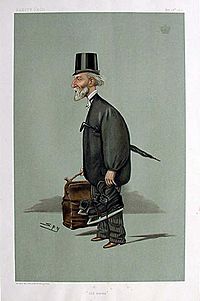Hubert de Burgh-Canning, 2nd Marquess of Clanricarde facts for kids
Quick facts for kids
The Most Honourable
The Marquess of Clanricarde
|
|
|---|---|

"Old Wares":
Clanricarde as caricatured by Spy (Leslie Ward) in Vanity Fair, May 1900 |
|
| Member of Parliament for Galway County |
|
| In office 1867–1871 Serving with William Henry Gregory
|
|
| Preceded by | Ulick Canning de Burgh, Lord Dunkellin |
| Succeeded by | Mitchell Henry |
| Personal details | |
| Born | 30 November 1832 |
| Died | 12 April 1916 (aged 83) |
| Nationality | British |
| Political party | Whig \ Liberal |
| Parents |
|
| Relatives |
|
Hubert George de Burgh-Canning, the 2nd Marquess of Clanricarde (born November 30, 1832 – died April 12, 1916), was an important figure in British and Irish history. He was an Anglo-Irish nobleman, which means he was from a British family living in Ireland. He was also a very wealthy man and a politician. His grandfather was George Canning, who was once the Prime Minister of Britain.
Hubert held several titles during his life. He was known as Lord Hubert de Burgh until 1862. Then he became Lord Hubert de Burgh-Canning until 1867. Finally, he was called Viscount Bourke until 1874, before he became the Marquess of Clanricarde.
Contents
Early Life and Family
Hubert was the son of Ulick de Burgh, 1st Marquess of Clanricarde and his wife, Harriet. Harriet was the daughter of the British Prime Minister, George Canning.
Hubert started his career in diplomacy. In 1852, he worked as an Attaché in Turin, Italy. An attaché is a person who works at an embassy, helping with diplomatic tasks. By 1862, he had become a Second Secretary there, which is a more senior diplomatic role. He later added "Canning" to his surname. This happened when he inherited land and property from his uncle, Charles Canning, 1st Earl Canning.
Hubert's older brother, Ulick Canning de Burgh, Lord Dunkellin, was a Liberal MP for Galway County in Ireland. When his brother passed away in 1867, Hubert became the next in line to inherit the title of Marquess. He also took over his brother's seat in Parliament. Hubert was elected as the Liberal MP for Galway County in 1867 and again in 1868. He retired from Parliament in 1871.
Land Ownership and Public Opinion
Hubert de Burgh-Canning owned a very large estate in Ireland, mainly in Portumna, County Galway. This estate covered about 52,000 acres (210 square kilometers). It was mostly farmland, and around 1,900 families lived there as tenants. These tenants often lived in poor conditions and struggled to farm the land.
Hubert was known as an absentee landlord. This means he owned a lot of land but did not live on it or visit it often. He managed his estates from London. Many people in Ireland were unhappy with his management style. His tenants paid him about £25,000 in rent each year, which was a lot of money at the time.
During the 1880s, there was a movement in Ireland called the Plan of Campaign. This movement aimed to help tenants get fair rents from their landlords. Hubert strongly opposed this plan. His refusal to lower rents or improve conditions for his tenants made him very unpopular. In 1882, his land agent, John Henry Blake, was murdered.
Because of the widespread problems on his estate, Irish Members of Parliament tried to pass a law to buy his lands from him. This would allow the land to be given to the tenants. Even the Prime Minister, Henry Campbell-Bannerman, spoke out against Hubert in Parliament. He criticized Hubert for never visiting his estates, even though many families had been forced off their land, leading to great hardship. Almost all members of the British Parliament supported the idea of taking over his estates.
From 1891, a group called the Congested Districts Board for Ireland tried to buy his estate. However, they were not successful until 1915, just a year before Hubert's death.
Later Life and Legacy
Hubert George de Burgh-Canning passed away in 1916 at the age of 83. He was living in London at the time and was buried in Highgate Cemetery. He left behind a very large fortune, estimated to be around £2,500,000.
When he died, most of his noble titles, called peerages, ended because he had no children. However, the title of Earl of Clanricarde passed to the 6th Marquess of Sligo. His vast fortune went to his sister's grandson, Henry, Viscount Lascelles. Henry later married Princess Mary, who was the daughter of King George V.
Images for kids



